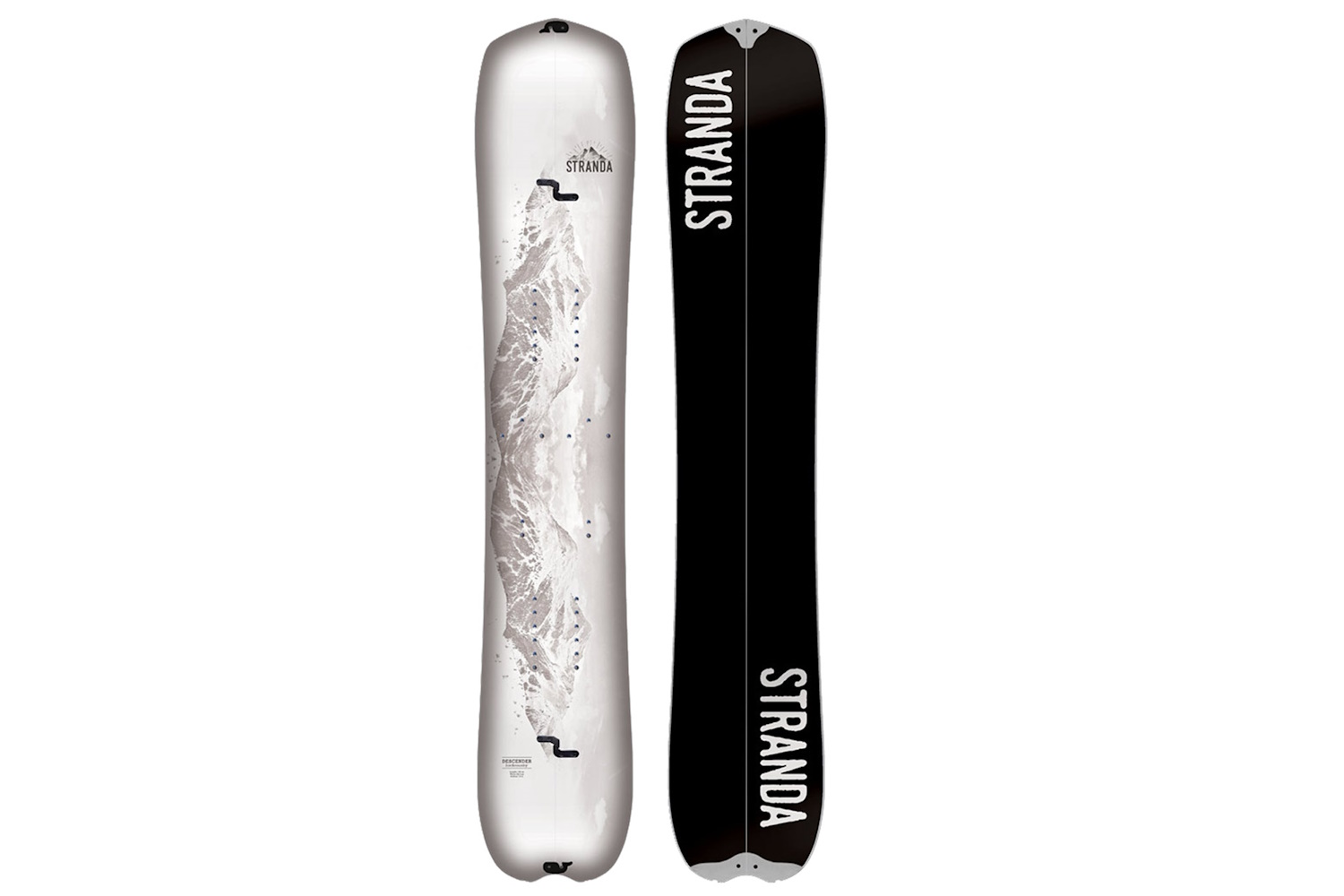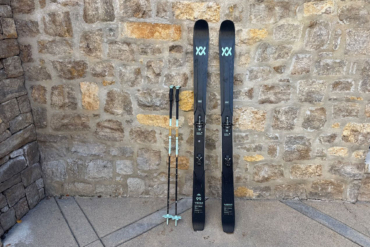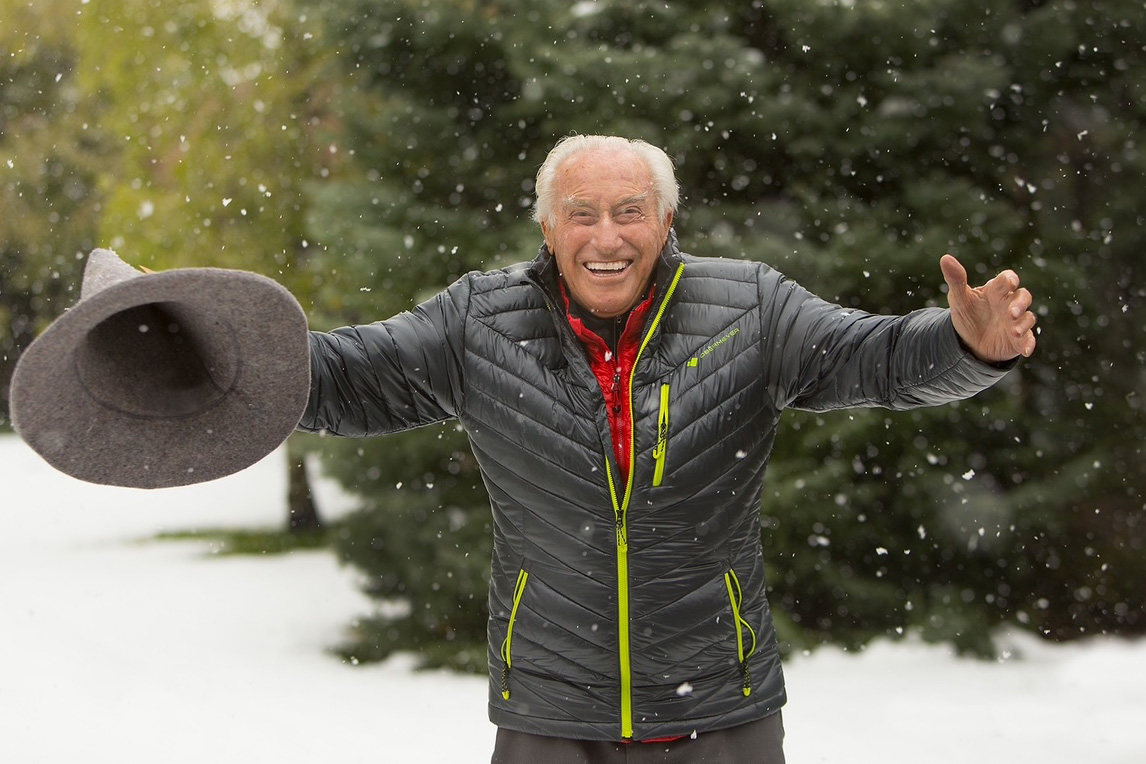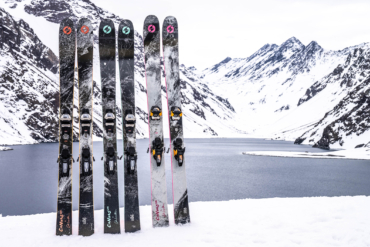When a splitboard reminds you of a well-muscled, thick-set bulldog, take the impression to heart. No different than the Stranda Women’s Descender Splitboard, this design courageously guards you through rough patches of white carpet while making you sporadically laugh, easily catching air and just as smoothly landing in deep pow. Nose-dive cartwheels excluded.
When buckling into this all-terrain splitboard last season, I was continuously pleasantly surprised. With a relatively compact silhouette, the board plows through crust yet is graceful to guide. The Descender disperses snow upon smack landings off pillow drops and is playful but strong.
In short: The Stranda Women’s Descender Splitboard ($895) is an excellent choice for ladies who want a directional design to ride in powder, weave through tight glades or other features, launch off obstacles, and carve through the backcountry season’s range of conditions from fluff to hardpack and ice.

- Setback: 2 cm
- Taper: 9 mm (size 152)
- Flex: 8
- Sizes: 148, 152
- Shape: Directional
- Profile: Low camber with minor rocker in the tip and tail
Pros
- Playful
- Stable in landings and high speed
- Excellent edging and traversing power
Cons
- Not the number-one choice for riding switch
- A beginner might consider a softer board
- Only two length options

Stranda Women’s Descender Splitboard Review
“Dropping,” I broadcasted into the handheld radio clipped to my shoulder strap. My senses surged and my heart fluttered with excitement, as they always do at the top of a backcountry line. But especially today: One of the deepest, most stable stacks of the season, and a lineup that doesn’t come every winter, especially midway.
I was on an early morning alpine tour with two partners, and we’d snowmobiled 6 miles through remote 12,000-foot peaks to reach the base of our zone, steep and untouched. We’d discussed our plan in advance, made our assessments, and now it was go time.
Below my feet, I’d strapped the Stranda Women’s Descender Splitboard, which was an excellent comrade for the climb: fairly lightweight, easy to swing through kick turns, and powerful to edge where the uptrack was packed down and slick.
Bumping the nose forward to launch down the initial pitch, a lofty canvas of pow, I hoped the splitboard performed well for the conditions. Not that riding deep snow is ever a bad time. But a well-crafted snowboard can certainly enhance the experience and even save my legs for the upcoming rounds. Or help prevent a tomahawk.
As I leaned back, the nose easily lifted above the glittering crystals, accelerating the board and me. My face became caked in a cold mask, flying up from below. With each alternating pressure of my heel and toe, the board responded quickly and precisely.
As the terrain began to roll over, I ollied the board. “Whoa! Ha!” I exclaimed, to no one except the snow elves. I was not expecting the Descender to respond with such a poppy demeanor, sending me airborne without much effort. Reaching my safety pad, I pulled aside and called on the radio.
“Wow, that was fun!” and as I’d later share, this splitboard was in a word, awesome. More specifically, the Women’s Descender Splitboard is agile and nimble yet holds steady while charging fast, steep, or intimidating terrain, as well as deep snow. Without a more aggressive sidecut or narrower waist, I was anticipating a somewhat sluggish ride — and it was nothing of the sort.
Stranda Snowboards officially arrived on the scene eight seasons ago, in 2015. The brand’s origin was more than a decade after Swedish founder Mats Drougge began studying and sketching surfy snowboards, inspired by the then-fresh movement of flowing on snow in the likeness of surfers on waves. The goal was to bring a sense of the sea to the peaks.
Later, the brand launched the men’s iteration of the Descender Splitboard in 2020, followed closely by the women’s-specific version in winter 21/22. The design has a tad softer flex compared to the men’s silhouette. The Descender is also the brand’s top-selling model overall — to which, I’m not surprised given its all-around performance and capability.

Directional Profile and Shape
Throughout the season, I had a chance to test the Stranda Women’s Descender Splitboard in the Colorado backcountry across a variety of snow conditions and terrain from sweeping face shots to narrow, steep chutes and chunky boilerplate. I was surprised at how well this underrated design performed.
Compared to riding this splitboard’s solid counterpart in-bounds, the halfsies version performed equally well in the backcountry — which is an achievement.
While the Descender is not marketed as a powder-specific design, the shape serves deep days. And all of the characteristics of this board square it up nicely as a dependable option for a range of objectives.
Rather than a twin board that equally balances your weight and energy between symmetrical front and back halves, this directional silhouette is designed to support forward momentum. The shape is slightly wider toward the nose versus the tail.
The profile is also directional. In a hybrid combination, there’s a low 4mm camber underfoot and well past the binding inserts, and a mild reverse rocker at the board’s ends. The camber is incrementally reduced toward the tip and tail, and it extends a bit further in the tail to compensate for the loss of power that comes with rocker.
Instead, the camber reaches farther in the back, compared to the front, which adds a whip to the board — the source of the poppiness. Then, the slight upturn helps the ends stay afloat and not catch.
Flex and Sidecut
With head-to-tail widths of 28.4, 24.8, and 27.5 cm on the 152 length, there’s a moderate taper. This design feels stout under foot but is also a joy to quickly zip back and forth through tight glades.
The 7.8m sidecut is not huge and offers a sweet spot for turns — not too whippy, not too large, but super navigable in tight terrain.
Compared to other splitboards, I found that this design was on the stiffer end of the spectrum — an 8 out of 10. But that snappy tail and the maneuverability through each turn meant the stiffness only supported the ride in a positive way. This board doesn’t shy away from hard, uneven surfaces and can weather turbulence.
Powerful Edge Hold, Damping
There are four gentle waves along each edge — including opposing sets on either side of the inserts and toward the nose and tail — dubbed the Power Bumps. The technical feature is similar to the Traction Tech produced by Jones Snowboards and the magne-traction available in the brands of Mervin Manufacturing, like GNU.
Stranda’s Power Bumps strengthen the edging power of the board, which is key in icy conditions and was noticeable, especially while traversing steep hardpack faces. They act like subtle teeth biting the surface. Based on the product’s diagram, the Power Bumps are likewise directional with more real estate dedicated to the protrusions toward the nose.
Mixed into the paulownia timber core are full-length poplar and ash wood inserts, triax glass with carbon stringers, and PU sidewalls with rubber strips along the edges for damping — all of which lowers the weight while reducing chatter. Overall, that mix of materials is durable and should last many seasons.

Climbing Skins and Hardware
Partnered with Kohla, the brand offers the Basic skin model as the precut Stranda Climbing Skins ($248), which we found excelled across various snow and skintrack conditions and ambient temps. Up top, a durable, wide metal clip easily slides onto the nose of the split skis.
At the tail of each ski, a metal clip with a sharp hook attaches to the edge via a small preset divot. The design is meant to save weight. The attachment functions, though, are not our favorite to use, because the narrow piece of metal needs to latch just right and is needle-pointed. It’s also not a deal-breaker.
The glue never gooped nor was it too sticky, but some of other testers did experience a skin peel-off a couple of times — the adhesion isn’t the hardiest. Again, not a deal-breaker. The glue still functioned on super-cold days. And the glide and grip of the mixed mohair blend worked well across the season’s evolving snowpack and air temps.
This was the first time I’d ridden a splitboard with the Phantom Hercules Hooks, which seem very stout, smoothly fit together, and never shifted under pressure.


Drawbacks
While the Power Bumps are a gold sparkle for the design, it’s worth noting that Jones Snowboards includes the Traction Tech on both the exterior and interior edges of models like the Women’s Solution Splitboard. When you’re skiing uphill, that tech can come into play when needing to dig a ski edge in.
For a rider looking to be totally balanced between the front and back foot, or someone that absolutely wants to ride switch, look elsewhere. Check out a twin shape and profile instead. While I could ride switch when I had to, steering backward with the Descender is not smooth or functional, given its directional design.
The same goes for a true powder board. If you’re looking to accelerate as fast as possible down glittering fields of glory, using minimal energy, go for a specific powder splitboard.
Another critique — there are only two size options at print: 152 and 148 mm. At under 5’6″, I ride a 152 most days, but there are plenty of snowboarders taller than I am.
The men’s Descender B.C. Splitboard comes in five sizes, including two wide options. I hope the menu is extended in the future to accommodate more body heights and weights. (Note: The most important way for brands to make those manufacturing updates is for them to hear a request from you and your local retailer!)

Stranda Women’s Descender Splitboard: Conclusion
Overall, the Stranda Women’s Descender Splitboard is a premium build that is meant to endure season after season of any objective a rider dreams up. This all-terrain design is strong, stalwart, and quick to turn without being grabby. Whether you’re plowing through deep powder at the top, managing sluff, or taking super steep drops, this board comes through.
The directional silhouette has a way of dispersing whatever conditions it flows through. Pushing through chunder. Traveling well, and fast, without requiring an exorbitant amount of effort to turn. Dancing through tight trees. Where this board shape doesn’t take an award is switch riding, but it’ll do that, too, when needed.
Looking ahead, the variables I still need to test this splitboard on include traversing across and carving down icy faces. That said, I’ve tested the Women’s Descender solid all-mountain snowboard in-bounds, and it’s one of the best designs I’ve ever ridden for traversing across concrete slopes, offering excellent edge hold and forward energy. The splitboard is loaded with the same technical features, so my expectations are high.
As a splitboarder who enjoys getting to know and depend on a setup, I appreciate a design like this one that supports a single quiver motto.
Hands down, the Stranda Women’s Descender Splitboard now sits among my favorite big mountain splitboards to date.








